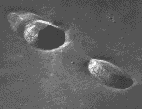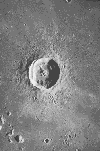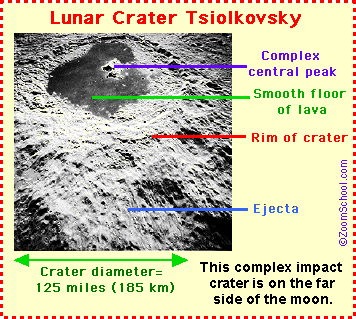
The lunar crater Aristarchus ( on the NW edge of the Oceanus Procellarum). This huge, circular crater is 25 miles (40 km) in diameter and 2.2 miles (3.6 km) deep (from rim to floor). There is a lot of ejecta (material thrown from the crater at impact) surrounding the crater. |
Impact craters are the remains of collisions between an asteroid, comet, or meteorite and the Moon. These objects hit the Moon at a wide range of speeds, but average about 12 miles per second (20 kilometers per second).
The surface of the moon is scarred with millions of impact craters. There is no atmosphere on the moon to help protect it from bombardment from potential impactors (most objects from space burn up in the Earth's atmosphere). Also, there is no erosion (wind or water) and little geologic activity to wear away these craters, so they remain unchanged until another new impact changes it.

Ptolemaeus is the large (diameter=164 km ) flat-floored crater at the top. Alphonsus (diameter = 108 km) is at the lower left and Albategnius crater (diameter = 114 km) is at lower right. |
These craters range in size up to many hundreds of kilometers, but the most enormous craters have been flooded by lava, and only parts of the outline are visible. The low elevation maria (seas) have fewer craters than other areas. This is because these areas formed more recently, and have had less time to be hit.
There are many rupes (lines of mountainous cliffs or scarps) on the lunar surface. These are remnants of the rims of ancient craters. The Rupes Altai is a mountain range about 315 miles (50 km) long on the moon.
Different Types of Impact Craters
The size, mass, speed, and angle of the falling object determine the size, shape, and complexity of the resulting crater. Small, slow objects have a low energy impact and cause small, simple craters. Large, fast objects release a lot of energy and form large, complex craters. Very large impacts can even cause secondary cratering, as ejected material falls back to the ground, forming new, smaller craters, or a series of craters.
 Most of the craters on the Moon are circular. The few craters that are not circular, like Messier and Messier A (pictured at the left) in the Mare Fecunditatis, are an enigma. Scientists do not know exactly how these oddly-shaped craters were formed.
Most of the craters on the Moon are circular. The few craters that are not circular, like Messier and Messier A (pictured at the left) in the Mare Fecunditatis, are an enigma. Scientists do not know exactly how these oddly-shaped craters were formed.
Complex Crater

Euler crater, a complex crater with a diameter of 17 miles (28 km) and a depth of 1.5 miles (2.5 km). |
Simple Crater

Moltke crater, a simple crater with a diameter of 4.3 miles (7 km). |
Most craters on the Moon that have diameters less than about 15 kilometers have a simple, bowl-like form.
Lunar craters with a diameter over about 15 kilometers have more complex forms, including shallow, flat floors made of solidified lava, central uplifting (a single peak, multiple peaks, or a ring), and terraces on the inner-rim walls.
Simple Impact Craters:
 Simple impact craters have bowl-shaped depressions, mostly with smooth walls. This type of crater generally has a diameter less than 9 miles (15 km). Their depth is about 20% of the diameter.
Simple impact craters have bowl-shaped depressions, mostly with smooth walls. This type of crater generally has a diameter less than 9 miles (15 km). Their depth is about 20% of the diameter.
Complex Impact Craters:
 Complex impact craters have a single or multiple peaks in the middle of the crater. These craters have diameters between about 12 and 110 miles (20 and 175 km), and the central uplift is usually one or a few peaks. Craters with a diameter over 110 miles (175 km) can have more complex, ring-shaped uplifts within the crater.
Complex impact craters have a single or multiple peaks in the middle of the crater. These craters have diameters between about 12 and 110 miles (20 and 175 km), and the central uplift is usually one or a few peaks. Craters with a diameter over 110 miles (175 km) can have more complex, ring-shaped uplifts within the crater.

The lunar basin Schrodinger is 200 miles (320 km) in diameter. Schrodinger also has an inner ring which is 92 miles (150 km) in diameter and about 75 percent complete. Schrodinger is one of the youngest impact basins on the Moon. |
Impact Basin: A impact basin is an impact crater that has a rim diameter greater than 185 miles (300 km). There are over 40 impact basins on the Moon. These catastrophic impacts produce faulting and other crust deformations. Material ejected from impact basins is distributed over wide areas.

Most of the craters on the Moon are circular. The few craters that are not circular, like Messier and Messier A (pictured at the left) in the Mare Fecunditatis, are an enigma. Scientists do not know exactly how these oddly-shaped craters were formed.
Simple impact craters have bowl-shaped depressions, mostly with smooth walls. This type of crater generally has a diameter less than 9 miles (15 km). Their depth is about 20% of the diameter.
Complex impact craters have a single or multiple peaks in the middle of the crater. These craters have diameters between about 12 and 110 miles (20 and 175 km), and the central uplift is usually one or a few peaks. Craters with a diameter over 110 miles (175 km) can have more complex, ring-shaped uplifts within the crater.

